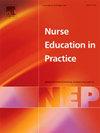The concept-in-action “Putting Oneself in Someone’s Place”: A three-year qualitative study of nursing students’ relational skill development
IF 3.3
3区 医学
Q1 NURSING
引用次数: 0
Abstract
Aim
This study examines the development of interactional schemes among nursing students, focusing on the concept-in-action "putting oneself in someone's place" and its relationship with empathy.
Background
The nurse-patient relationship constitutes an essential foundation of nursing practice. While empathy is considered a crucial relational competency, the mechanisms through which students develop this competency remain underexplored.
Design
A three-year longitudinal qualitative study, anchored in the framework of professional didactics, examining the evolution of nursing students' interactional schemes.
Methods
Twelve nursing students were followed throughout their training program. Data were collected through video recording of real interactional situation between nursing students and patient and self-confrontation interviews, then analyzed according to Vergnaud's scheme components.
Results
Students frequently mobilize the concept-in-action "putting oneself in someone's place" to guide their interactions with patients. Unlike empathy, this concept relies on social projection whereby students apply their own expectations and experiences to the patient's situation. This approach facilitates navigation through interactional uncertainty but demonstrates limitations in recognizing patient specificity.
Conclusions
The identified concept-in-action differs significantly from empathy as defined in nursing science. It potentially represents an intermediate stage in the development of relational competencies. The findings underscore the importance of pedagogical strategies that facilitate the transition from a projective approach to a more nuanced empathy centered on patient alterity, essential for personalized care.
行动中的“设身处地”概念:三年护生关系技能发展的质性研究
目的研究护生互动机制的发展,重点研究行动中的“设身处地”概念及其与共情的关系。护患关系是护理实践的重要基础。虽然移情被认为是一种重要的关系能力,但学生发展这种能力的机制仍未得到充分探讨。设计一项为期三年的纵向定性研究,以专业教学法为框架,研究护理学生互动计划的演变。方法对12名护生进行全程随访。通过视频记录护生与患者的真实互动情况和自我对抗访谈来收集数据,然后根据Vergnaud的方案成分进行分析。结果学生经常运用“设身处地”的行动概念来指导与患者的互动。与同理心不同,这个概念依赖于社会投射,学生将自己的期望和经验应用到病人的情况中。这种方法有助于通过相互作用的不确定性进行导航,但在识别患者特异性方面存在局限性。结论所识别的行动概念与护理学定义的共情有显著差异。它潜在地代表了关系能力发展的中间阶段。研究结果强调了教学策略的重要性,这些策略有助于从投射性方法过渡到以患者替代为中心的更细致入微的同理心,这对个性化护理至关重要。
本文章由计算机程序翻译,如有差异,请以英文原文为准。
求助全文
约1分钟内获得全文
求助全文
来源期刊

Nurse Education in Practice
NURSING-
CiteScore
5.40
自引率
9.40%
发文量
180
审稿时长
51 days
期刊介绍:
Nurse Education in Practice enables lecturers and practitioners to both share and disseminate evidence that demonstrates the actual practice of education as it is experienced in the realities of their respective work environments. It is supportive of new authors and will be at the forefront in publishing individual and collaborative papers that demonstrate the link between education and practice.
 求助内容:
求助内容: 应助结果提醒方式:
应助结果提醒方式:


